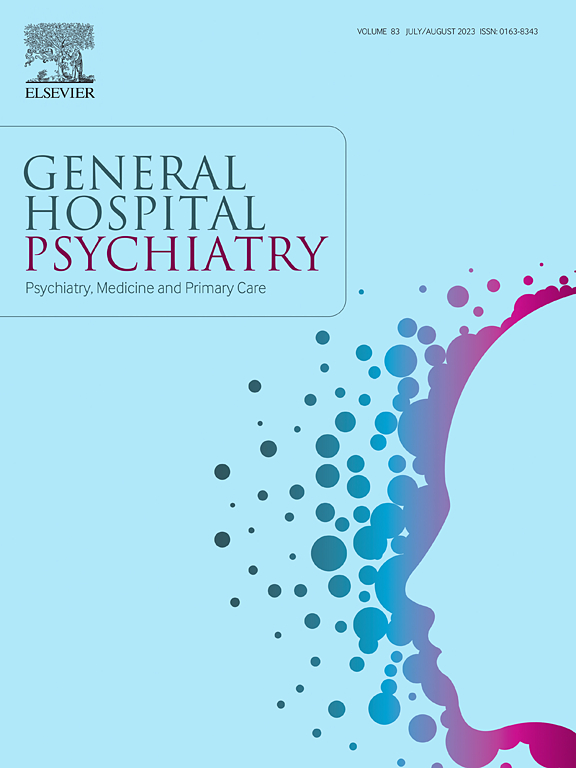抑郁症患者快感缺乏与言语特征之间的关系:一项横断面研究
IF 3.7
2区 医学
Q1 PSYCHIATRY
引用次数: 0
摘要
背景:快感症是抑郁症的核心症状。大多数快感缺乏症评估依赖于自我报告,这并不能准确反映快感能力,而且会受到个人主观性的影响。因此,需要客观的指标。快感缺乏可能导致抑郁症患者的语言特征不同。因此,语音特征已成为一个新兴的客观指标,在抑郁症的评估。本研究旨在通过在多任务范式下比较快感缺乏患者和非快感缺乏患者的言语特征,探讨抑郁症患者快感缺乏与言语特征之间的关系。方法共招募166例抑郁症患者进行研究。语音数据通过语言流畅性测试、文字阅读、视频描述和半结构化访谈收集。初步分析采用协方差分析(ANCOVA)和偏相关分析。我们根据抑郁症的严重程度对患者进行分组,并进行事后t检验或Mann-Whitney U检验进行比较。采用Benjamini-Hochberg方法控制多重比较中的错误发现率。结果调整焦虑严重程度(用7项广泛性焦虑障碍量表GAD-7测量)后,有无快感缺乏患者的言语特征无显著差异。同样,在控制抑郁严重程度后(用17项汉密尔顿抑郁量表,HAMD-17测量),言语特征和快感缺乏程度之间没有明显的相关性。事后分析显示,17种言语特征与抑郁严重程度相关(|r| <;0.3,效应量小),但在基于抑郁严重程度的每个亚组中,快感缺乏患者和非快感缺乏患者在言语特征上没有差异。结论有无快感缺乏症患者在不同抑郁程度下言语特征无显著差异。然而,言语特征与抑郁严重程度独立相关。未来的研究可能会通过优化语音任务模块或评估多维韵律特征来完善研究方法,以进行更深入的分析。本文章由计算机程序翻译,如有差异,请以英文原文为准。
The association between anhedonia and speech features in depression: A cross-sectional study
Background
Anhedonia is a core symptom of depression. Most anhedonia assessments rely on self-reporting, which does not accurately reflect hedonic capacity and is biased by individual subjectivity. Therefore, objective indicators are needed. Anhedonia may result in different speech features among depressive patients. Thus, speech features have become an emerging objective indicator in depression assessment. This study aims to investigate the relationship between anhedonia and speech features in individuals with depression by comparing the speech features of patients with and without anhedonia in a multitasking paradigm.
Methods
A total of 166 patients with depression were recruited for the study. Voice data were collected through the Verbal Fluency Test, Word reading, Video description, and Semi-structured Interviews. The primary analysis was performed using analysis of covariance (ANCOVA) and partial correlation analysis. We grouped patients based on the severity of depression and performed post-hoc t-tests or Mann-Whitney U tests for comparisons. The Benjamini-Hochberg method was used to control for False Discovery Rate in multiple comparisons.
Results
After adjustment for anxiety severity (as measured by the 7-item Generalized Anxiety Disorder Scale, GAD-7), no significant differences in speech features were observed between patients with or without anhedonia. Similarly, after controlling for depression severity (as measured by the 17-item Hamilton Depression Scale, HAMD-17), no significant correlation was found between speech features and the degree of anhedonia. Post hoc analyses showed that seventeen speech features were correlated with depression severity (|r| < 0.3, small effect sizes), but no differences in speech features were found between patients with anhedonia and those without anhedonia within each subgroup based on depression severity.
Conclusion
Speech features do not differ significantly between patients with or without anhedonia at any level of depression severity. However, speech features were independently correlated with depression severity. Future studies may refine research methodology by optimizing speech task modules or assessing multidimensional prosodic features for more in-depth analysis.
求助全文
通过发布文献求助,成功后即可免费获取论文全文。
去求助
来源期刊

General hospital psychiatry
医学-精神病学
CiteScore
9.60
自引率
2.90%
发文量
125
审稿时长
20 days
期刊介绍:
General Hospital Psychiatry explores the many linkages among psychiatry, medicine, and primary care. In emphasizing a biopsychosocial approach to illness and health, the journal provides a forum for professionals with clinical, academic, and research interests in psychiatry''s role in the mainstream of medicine.
 求助内容:
求助内容: 应助结果提醒方式:
应助结果提醒方式:


